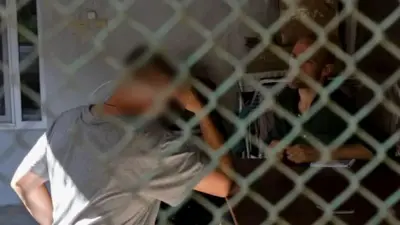We've updated our Privacy and Cookies Policy
We've made some important changes to our Privacy and Cookies Policy and we want you to know what this means for you and your data.
Bacterial 'striptease' evades antibiotics
Image source, Newcastle University
- Author, James Gallagher
- Role, Health and science correspondent, іЙИЛүмКЦ News
Bacteria have been caught "stripping off" in order to evade antibiotics and survive, scientists show.
Researchers at Newcastle University filmed bacteria "undressing" and taking off their outer layer - or cell wall.
Antibiotics can attack cell walls so scientists think this is a new form of drug resistance and could explain why some infections keep coming back.
Top Stories
But experts said it was still unclear if this was having an impact on patients.
What are they taking off?
Some species of bacteria have a cell wall built out of sugars and amino acids (the building blocks of protein).
Top Stories
It gives the bacterium shape and protection but it is also a weak spot that can be exploited by antibiotics.
The first antibiotic to be discovered, penicillin, disrupts the cell wall and causes bacteria to burst.
The study, , looked at bacteria from elderly patients with urinary tract infections that kept coming back.
Researchers spotted that some bacteria were responding to antibiotics by slipping out of their cell wall in order to escape the drug's effects.
Does this keep them alive?
The idea of bacteria existing outside of their cell wall is not new - they are called L-form bacteria.
But the researchers say this is the first time it has been shown the bugs can use this trick in order to survive antibiotic treatment.
"It's absolutely fascinating, we're seeing something different," Dr Katarzyna Mickiewicz, researcher at Newcastle University told the іЙИЛүмКЦ.
She added: "Not all survive, only a few, but it may be enough to cause recurrent infection."
You can see the moment bacteria strip off their cell wall as they lose their clear (in this case rod-like) structure and become bigger and more flimsy.
Top Stories
The weaker L-form of the bacteria should get mopped up by the body's immune system, but this might not happen in elderly patients or people with some conditions that also weaken the body's defences.
The cell wall later reforms once the antibiotic has gone.
How big a problem is it?
Bacteria have many tricks up their sleeve in order to survive, such as pumping the antibiotic out of their cells or breaking the chemical down or hiding whatever the drug attacked.
Most of these require a mutation in the genetic code of the bacterium, which can then be shared with neighbouring bacteria or passed on to any descendants.
However, the research team says that does not seem to be the case with the cell wall.
Image source, Newcastle University
Dr Mickiewicz told the іЙИЛүмКЦ: "In that sense, it is more worrying as they don't need to acquire anything, they don't need to evolve and they probably do it far more than we realise.
"I think this is potentially relevant to virtually all recurrent infections by bacteria, it's potentially very widespread and contributes to many diseases."
Could this lead to new treatments?
Dr Mickiewicz says the next stage is to establish which bacteria have this response and what role it is playing inside patients.
But she says the work may lead to new ideas for treatment.
It may be possible to overcome this resistance with combinations of drugs that attack both the cell wall and a bacterium's inner workings, she argues.
"This is an interesting academic story, but its clinical relevance is unclear," Prof Laura Piddock, from the University of Birmingham and the director of scientific affairs at the Global Antibiotic R&D Partnership, told the іЙИЛүмКЦ.
She added: "I do not view this as a mechanism of antimicrobial resistance 'as we know it'.
"This is a response to exposure to an antibiotic that allows the bacteria to survive in the presence of the drug."
And said the recommended first choice antibiotics for urinary tract infections do not attack the cell wall.
Follow James .
Top Stories
More to explore
Most read
Content is not available








